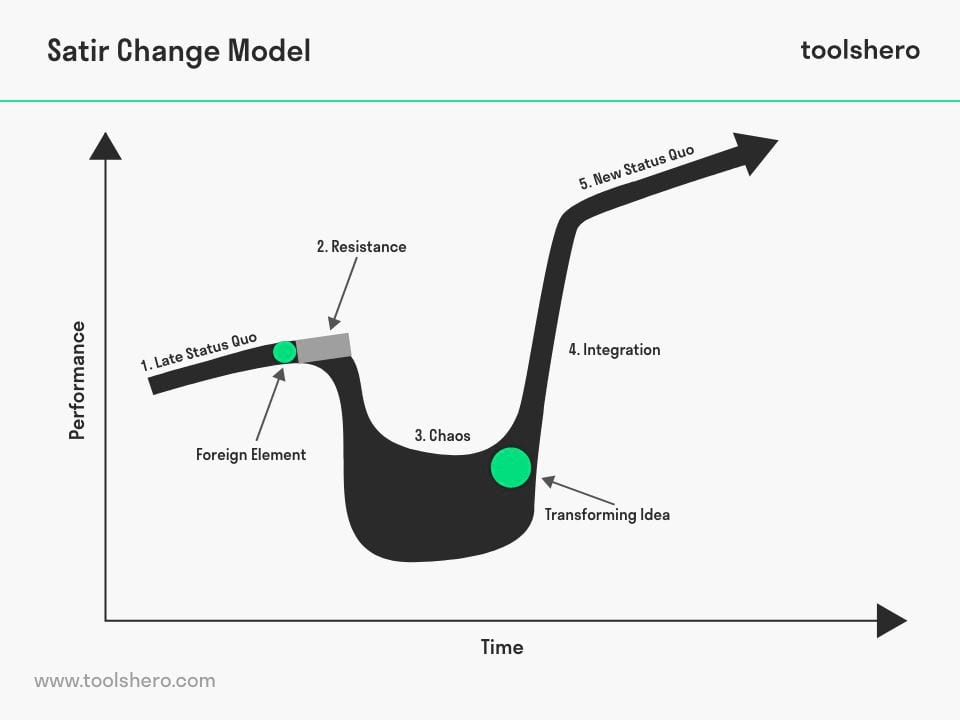Satir Change Model explained

Satir Change Model: in this article the Satir Change Model is explained in a practical way. Next to what it is, this article also highlights the phases of change and the difficulty of implementing change. After reading it you will understand the basics of this change management tool. Enjoy reading!
What is the Satir Change Model?
The Satir Change Model is a change management model developed by family therapist Virginia Satir. It is based on the Kubler-Ross model, as it includes the five stages of grief. These stages are applied in a change management process.
Satir Change Model: what are the phases of change?
The Satir Change Model is an effective way to predict and monitor the impact of change on the overall performance of employees. Not only the performance is discussed in this model. The effects of change on the feelings, thoughts and physiology of employees are also described.
The model consists of the following five phases:
- Late Status Quo
- Resistance
- Chaos
- Integration
- New Status Quo
This method is mainly aimed at mapping the consequences and impact of changes on performance, rather than implementing the change itself or addressing its negative effects.
It is therefore important to use this change management model in combination with other methods that do support the changes effectively.
Satir Change Model: why is it difficult to implement changes?
Experienced managers know that implementing change and managing it in the long term is not easy.
Yet it is often an absolute necessity that it is done well. Companies that want to survive and grow must strive to change with the market movements in a highly competitive environment.
Satir Change Model: the ability to change as a core competency
Change management has become a core competency precisely because of the competitive environment and rapidly changing market. Many organizations fail to do this. This is mainly due to the effects of change.
Change is something that upsets people. It increases the chance of failure, reduced quality, loss of production or simply failure. On the other hand, there is a positive side to change. Their effects are often important for the survival of an organization.
Employees must therefore be at the center of the change process. It is essential that they understand why the change is necessary and that they are properly guided in dealing with the problems they experience in the transition. It is mainly insecurity and fear of the unknown why people resist change.
To counter this and to remove this barrier, organizations must ensure that the change process is experienced as positive. There are a number of options for achieving this. These will be discussed in this article. Communication and training are central to this.
The Satir change model focuses mainly on people in this process. It describes the most important phases in a change process, the transition between phases, the effects of each phase on the employees and how best to deal with this.

Figure 1 – the Virginia Satir Change Management Model – Toolshero
Phase 1: Late Status Quo
The late status quo phase feels familiar to employees. Most days are similar and employees know exactly what to expect from the workday and from each other as colleagues.
Time is running smoothly, the months are ticking away and performance is more or less the same. Sometimes there are small fluctuations in performance. A typical way to describe this course of events is: business as usual.
Many people feel comfortable in this phase. Others feel bored, frustrated, or slightly anxious. Yet a sense of familiarity and calm prevails.
Group dynamics in the status quo
The dynamics between team members and other colleagues is also consistent. They either feel a sense of belonging and shared identity, or frustrations start to build up more often. They do know how to interact with each other and roughly how everyone reacts in certain situations.
Behavior in this phase, and other phases, is governed by implicit and explicit rules. Everyone attaches great importance to these rules. Even if they are harmful or less fun. For example, the chief of an engineering team has a hard requirement that all projects must be completed on time.
In the event that some engineers in the group become ill, the rest of the group knows that they are expected to fill the gap so that the project is completed on time. Even if they have to work 10 hours a day.
If this happens once in a while, the team can probably handle it well. However, if this happens too often, disagreement and dissatisfaction will arise and the project will fall apart. We then speak of a dysfunctional group.
One symptom of this is poor communication. Team members begin to blame each other, have poor handling of emotions such as anger, and are generally stressed. Stress can lead to even more physical discomfort, such as headaches and stomachaches. This can eventually lead to even more absenteeism.
New input such as information and new concepts can then lead to an opportunity for improvement.
Phase 2: Resistance or a Foreign Element
In this phase of the Satir Change Model, something happens that shatters the familiar feeling from the first phase. That can be many things. An important event, or new information that overturns old assumptions, customs, and practices.
For example, a company is reorganizing, giving different people new roles. Or you win a lottery. So it doesn’t necessarily have to be something negative. Something that causes the old status quo to change substantially falls under this phase.
Group dynamics in times of resistance
This foreign element causes a reaction to be necessary. This also happens in groups. A foreign element threatens the stability of existing power structures.
Most members of a team therefore resist the change, challenging its validity, avoiding the problem or blaming someone for the arrival of this element.
These blocking techniques are accompanied by physical reactions, such as a closed posture or change of breath.
Resistance hinders awareness. Members therefore need help to open up to and become aware of the situation.
Phase 3: Chaos
The foreign element ensures that an employee, team or group ends up in chaos. This is the third phase of the Satir Change Model. In the chaos phase you are suddenly in unknown territory, completely opposite of the late status quo.
People in organizations and groups begin to behave in unusual ways. They are easily stressed, hurt, scared or uncomfortable. They may also feel very elated, with a strong sense of urgency. It’s a rollercoaster, from one feeling to another.
Group dynamics in a chaos period
People receive a lot of stimuli in this phase and generally have many ideas about what they should do. There are also many general reactions. People withdraw, others try to take control and a small part of the group ignores everything around them. Some of these actions work and some don’t.
This can only add to the confusion. Behavior, feelings and performance are unpredictable. The chaos period is a very creative period, although the sense of urgency and stress is experienced as stronger.
The group dynamics also change a lot. Relationships shatter, old expectations of each other are no longer valid and old behavior may no longer be possible. This ensures that the sense of belonging and partial identity is lost. This is accompanied by fear, vulnerability and sadness. It can even cause physical reactions such as tremors, panic attacks, dizziness, tics and skin rashes.
Part of a team or group can actually not perform well at all in this phase. Some will therefore look for a new job, in search of new meaningful and lasting relationships. Chaos is, in addition to a period of creativity, a period of erratic performance and doom.
Many employees, as well as management, need help during this period to focus on their feelings and acknowledge their fears. This chaos period is essential for the transformation process.
Phase 4: Integration
Employees often create many new ideas in the chaos. This happens in the fourth phase of the Satir Change Model. Eventually there will be a transformative idea, or a thought that helps to understand the foreign element.
Sometimes a transformative idea comes with an aha-moment, but it’s not always so obvious. The only way to know if something works, is to try it and see what happens.
When a transformative idea is found that works, the group or employee becomes excited. In this phase, new lasting relationships arise that offer an opportunity for new connections and a new shared identity, either with other people.
Group dynamics in an integration process
An example is a group of accountants that switches to a new computer system. At first, there is a lot of resistance out of fear of the unknown, but they soon discover that some skill with this system makes them a better player in the market. They then embark on a powerful transition to the new system.
Awareness of new possibilities is therefore an important part of this phase. Members can feel really invincible, euphoric, because the new idea is so powerful that it works like a panacea.
However, people still need support in this phase. If things don’t work the first time, they can get frustrated. As a result, they may become disconnected from their new relationships and their renewed motivation lapses. The danger of this is that they end up in chaos again.
Phase 5: New Status Quo
In the new status quo, everything is starting to look like the previous status quo. Performance begins to level off and results are achieved with less concentration and focus.
People feel good about how well they have learned to cope with the new situation and begin to pay attention to other areas of life.
An effective group remains calm and alert. Group members feel free to observe and communicate what is happening. Everyone feels safe and encourages each other to resolve imbalances so that there is less resistance to new changes.
Now it’s your turn
What do you think? Do you recognize the explanation about the Satir Change Model? Do you recognize the different phases of change? Have you ever felt overwhelmed by things that changed? Did you notice that afterwards the new also quickly became accustomed? Do you have any tips for coping with change better? Can you share examples of situations where change is often desired? Do you have any other tips or comments?
Share your experience and knowledge in the comments box below.
More information
- Satir, V., Corrales, R. G., Price, R. R., & Gilmore, D. (1977). Virginia Satir. Cognetics.
- Emery, D. H. (1998). Managing yourself through change. Inspired Leadership for Software People, 1-8.
- Young, C. (2014). Managing change. The problem solution framework, 56.
- Cameron, E., & Green, M. (2019). Making sense of change management: A complete guide to the models, tools and techniques of organizational change. Kogan Page Publishers.
How to cite this article:
Janse, B. (2022). Satir Change Model. Retrieved [insert date] from Toolshero: https://www.toolshero.com/change-management/satir-change-model/
Original publication date: 06/09/2022 | Last update: 06/27/2023
Add a link to this page on your website:
<a href=”https://www.toolshero.com/change-management/satir-change-model/”>Toolshero: Satir Change Model</a>












